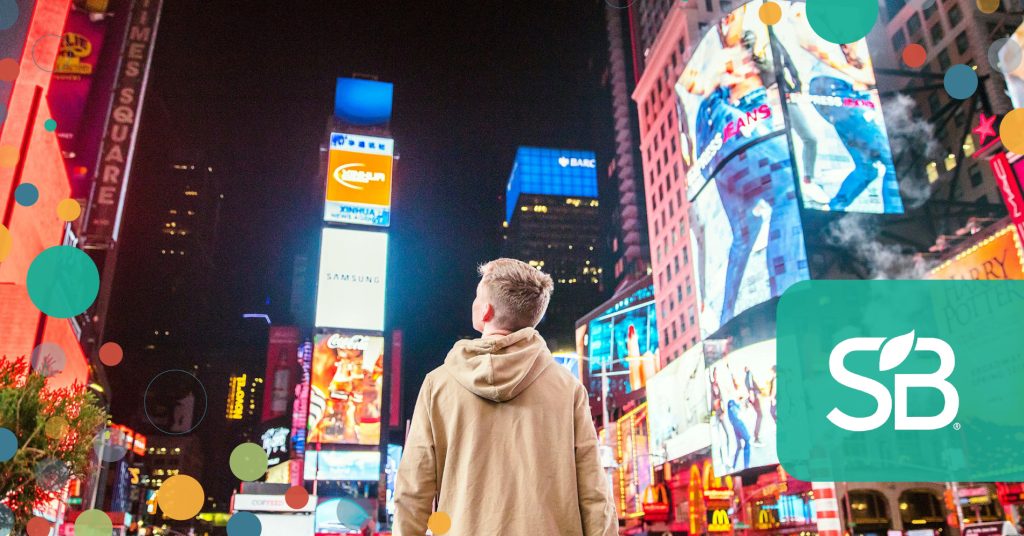Monitoring Media: Reining in the Broader Impacts of Brand Communications
7 min read
A big topic for the Sustainable Brands® community is increasing the
effectiveness of marketing and advertising communications in helping drive more
sustainable consumer habits and lifestyles. But what about the other social and
environmental impacts of corporate communications? Two rich discussions at
SB’24 San
Diego this
week dove deeper.
Tackling GHGs in marketing and advertising
The Sphere in Las Vegas has the world’s largest outdoor advertising digital
LED screen | Image credit: Shelby L.
Bell
When thinking of a product’s emissions, you may think of what the product is
made of, how it is shipped, or how it is used as the biggest contributors to its
footprint. In reality, one of the biggest sources of emissions has been largely
overlooked until
recently:
Digital marketing and advertising. A Monday afternoon workshop explored best
practices for calculating and reducing greenhouse gas (GHG) emissions in
marketing and advertising, while offering actionable insights for brands from
industry experts and case studies.
Emissions occur at various stages of the advertising lifecycle: from production,
media planning and delivery to end-of-life — for example, digital ads stored on
servers. Digital channels, representing 70 percent of all advertising spend,
contribute 3.5 percent of global emissions. A significant portion of these
emissions arises from the production and distribution phase — where the use of
data centers, consumer devices and media transmission play a role.
Rachel Schnorr, USA
Membership Director at Ad Net Zero — a nonprofit
driving climate action in the advertising industry, which recently released a
framework to improve and standardize measurement of emissions from digital
media
— put it into context: “Advertising is estimated to contribute between two and
three percent of global emissions — comparable to the aviation industry. If that
doesn’t sound important, consider the fact that advertising has an outsized
influence on the remaining emissions of all the other industries in which
marketing plays a key role.”
The role of ad agencies and media providers
As Martin Bryan — Global Chief
Sustainability Officer for IPG Mediabrands —
pointed out, the ad industry is uniquely positioned to lead brands in
decarbonizing their media and marketing. By adopting sustainable advertising
practices,
agencies can drive innovation and growth through their purpose-driven work.
“The crisis is urgent, and it can be paralyzing,” Bryan said. “But the
opportunity we have as marketers when we think about growth potential is
enormous.”
Advertising agencies and media owners need to be part of the solution. Dr. Bill
Wescott, managing partner at
BrainOxygen LLC, emphasized the importance of
marketers and advertisers in making themselves and their clients more impactful.
“Advertisers have superpowers that can convince consumers to change their
behavior,” Westcott said. “This is how we can change the world; the next lever
for change is behavior change, and no one on the planet is better at behavior
change than advertisers.”
Agencies should use the growing number of
resources
and frameworks to account for GHG emissions in their operations and use this to
help clients measure their Scope 3
emissions.
Media owners and ad-tech solution providers must also commit to disciplined
action, ensuring that the entire supply chain is aligned with sustainability
goals.
Tools and strategies for reducing emissions
A variety of tools are available to help companies reduce their
advertising-related emissions. One example that Schnorr mentioned is the
AdGreen tool, which allows
companies to measure the carbon footprint of ad productions. By inputting data
from a specific shoot, AdGreen calculates the emissions generated — helping
companies identify where reductions can be made.
A critical step for companies is to conduct Life Cycle Assessments (LCAs) of
their ad campaigns. This involves breaking down each advertising modality —
print, television, out-of-home or digital — into distinct life cycle stages,
from content production to media disposal. For example, in print ads, media
production generates the most emissions; while for television, distribution
(transmission and use by viewers) is the highest emitter.
Jason Melbourne, Chief Data
Officer at Fairglow, used its platform to examine
the emissions from marketing and advertising of a multibillion-dollar French
cosmetics company. Fairglow was able to break down its marketing budget across
four different advertising modalities: print, television, out-of-home (for
example, billboards) and digital media. The analysis showed that print ads
generated the most emissions in media production, while television ads saw the
highest emissions from media distribution due to the energy required for
transmission and viewer devices.
The case study demonstrated that companies can reduce their environmental
impact, specifically in marketing and advertising, by understanding where
emissions are generated and applying tailored frameworks and strategies to
reduce them.
“We believe you have to measure before you reduce,” Melbourne said. “10 years
ago, no one thought marketing had that big of an impact on emissions — and now,
we know better.”
As the marketing and advertising industry continues to evolve, it is critical
for companies to incorporate GHG emissions into their decision-making processes.
By leveraging tools, frameworks and expert guidance, companies can reduce their
carbon footprint while driving innovation and growth. Collaboration across the
industry, from agencies to media providers, will be essential to ensure that the
future of advertising is not only profitable but sustainable.
Check out more highlights from throughout the week at SB’24 San Diego!
Combating misinformation: How strategic storytelling and media partnerships can shape public perception on climate and social issues
![]()
Image credit: Rawpixel
In today’s digital-first world, effective storytelling is important for shaping
public perception — especially around critical issues such as climate change,
social justice and sustainability. However, the rise of technologies such as
AI
and ad tech has fueled the spread of misinformation and disinformation —
presenting significant challenges for reaching audiences with informed,
objective, accurate narratives.
Due to its power to fuel conflict, threaten democracy and human rights, and
undermine public health and climate action, disinformation topped the World
Economic Forum’s 2024 list of global
risks;
and the Global Alliance for Public Relations and Communication Management
has called for the UN to recognize the importance of responsible
communication by establishing it as the 18th Sustainable Development
Goal.
A Wednesday afternoon panel of media leaders provided insights for brands on
engaging and partnering with news media to amplify authentic stories and combat
misinformation.
Challenges of misinformation and ad tech
Ad tech — which allows brands to tailor where their ads appear and which
demographics see them, by flagging keywords in articles (such as “DEI” or
“climate change”) that they don’t want to appear near their ads — has had a
huge impact on both misinformation and
journalism.
Because of its pervasiveness, huge portions of the population now don’t see ads
that fund the journalism being produced, which has drastically cut ad revenues
for publications. This has caused layoffs of reputable journalists across the
industry — which has led to the emergence of more and more rhetoric and
disinformation. According to a study by
Adalytics,
21 percent of economist.com articles, 30.3 percent
of nytimes.com, 43 percent of
wsj.com, and 52.8 percent of articles on
vice.com are being labeled as “brand unsafe.”
“Advertising funds journalism,” said Alexis
Schwartz, Executive Director of
The Guardian US. “To have great journalism, we need paid media support.”
Despite ad tech’s effects, the notion of news being unsafe for brands is a myth.
In fact, a Guardian survey found that most readers feel more positively about
brands (or simply don’t care at all) when their ads appear alongside content
deemed risky.
Authenticity in storytelling
Louise Wilson, SVP of Partnerships
at Futerra, underscored the need for authentic
storytelling to drive engagement. She emphasized combining “logic and magic” —
factual content supported by creativity — to create compelling narratives that
resonate with audiences.
“If you just come up with a strong strategy, but if you don’t talk about it, you
will get
greenhushed,”
Wilson said. “But if you just work on the comms side of it with great messaging,
you will be accused of
greenwashing.”
An example is Formula 1’s
transformation from a
gas-guzzling sport to one focused on sustainability. With Futerra’s help, the
legendary motor racing series developed a robust strategy to decarbonize its
events and adopt 100 percent synthetic fuels by 2026. Their creative use of
messaging not only reached the media but also won over fans — with 82 percent
appreciating their sustainability efforts and 60 percent willing to change
behaviors because of it.
Paid and earned media
Both Schwartz and Wilson acknowledged the importance of both earned and paid media in
amplifying impactful stories. Earned media, while validating the work done,
often has a short life span. Paid media, on the other hand, can extend the reach
of these stories and create longer-lasting impressions. The Guardian has
partnered with organizations such as the Ford Foundation to create sponsored
content that is just as impactful as traditional journalism. Schwartz stressed
that paid content can be critical in funding high-quality journalism while
maintaining editorial independence through donations, grants and philanthropic
support. This can be seen in the piece funded by the Ford
Foundation,
that highlights grants offered to the informal economy during COVID-19, which
provided income for people including taxi drivers, dog walkers and food cart owners
when they didn’t have any assistance.
Humanizing climate action
Futerra’s work with Mars Petcare to
develop an insect-based cat food is another example of blending strong
communications with innovative ideas. By carefully managing the narrative and
engaging with content creators and then the press, they shifted the media and
public perception on a risky
topic
— showing how thoughtful, authentic storytelling can influence behavior.
Ultimately, the session reinforced that successful storytelling in news media
requires collaboration, authenticity and a strategic approach that combines
earned and paid media. Misinformation and ad tech challenges can be addressed by
ensuring that accurate, compelling narratives reach the public in a brand-safe
environment.








